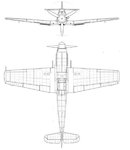Civettone
Tech Sergeant
The G.55S would also work. Easier to produce.I'm not saying that Germans had to produce Re.2005s. I'm saying that's possible to carry a bomb, or two, or even a torpedo (the Re.2005 had the same loading capability of the Re.2001/2002, that included a W125/450/3.63 600kg torpedo), under the fuselage with a ventral radiator, and incidentally it requires the same undercarriage disposition the Bf109 already had.
The real problem here is that we simply do not know ! We have all read that the Fiat G.55 took 15,000 man hours to build and that it could be brought down to 9,000 through rationalisation and mass production techniques. BUT who came up with these figures? Can we really rely on them?That's producing it in Italy. Even producing a Bf109 in Italy would require much more hour of work than producing it in Germany. Were the industrial conditions more than the projects that made the difference.
I believe they are estimates. I guess they were based on the technological level and modernity of the factories of Fiat and Reggiane. Fiat probably had the advantage here? I also read that the Reggiane factory was very modern. For sure, the German factories were much more advanced. Even so, I do not believe anyone in the 1930s would have thought the Bf 109 could be produced in just 2,000 manhours but that is what happened. The Fiat G.55 but also the other 5-series could probably have been produced even faster. However, this would require a lot of investments in specialized machinery and continuously training your work force. If you just invest enough, who knows where you will end up?
Kris

